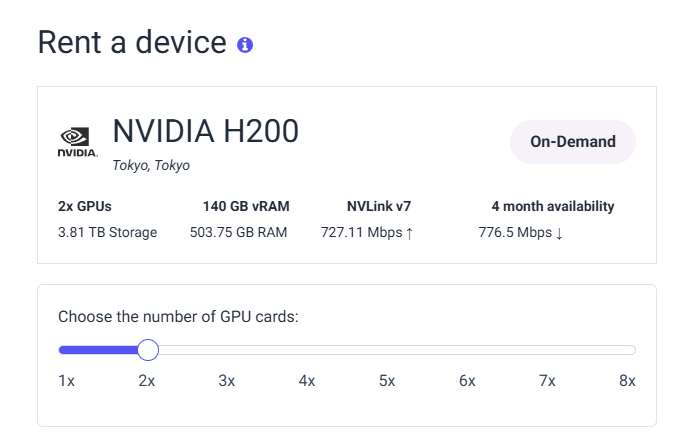Author: Ben Moore
Read Time: 3 Minutes
 We’re excited to announce Card-Level Configurability to the GPU Trader platform: now users can choose the exact number of GPUs they want in a node.
This launch emphasizes card-level configurability, giving users complete control over how many cards they deploy per job and moves away from inflexible, fixed-instance models.
We’re excited to announce Card-Level Configurability to the GPU Trader platform: now users can choose the exact number of GPUs they want in a node.
This launch emphasizes card-level configurability, giving users complete control over how many cards they deploy per job and moves away from inflexible, fixed-instance models.
Your Workload, Your Node Configuration
Instead of bundling GPUs into fixed-instance sizes (2x A100, 4x A100, etc.), GPU Trader gives users complete control over the number of GPUs in a node. Need one A100 for lightweight fine-tuning? Great. Need six for a multi-GPU training run? No problem. You’re in control. This flexibility means you can:- Avoid overprovisioning: Don’t pay for 8 cards when your job only scales efficiently to 4.
- Reduce queuing times: Smaller, customized jobs are easier to schedule and deploy.
- Optimize cost-performance: Align your node size with the parallelism and throughput sweet spot for your workload.
Smarter Resource Matching
This flexibility isn’t just good for users, it’s better for the ecosystem. Infrastructure is often offered in a narrow set of GPU configurations because simplicity is prioritized over efficiency. But this approach creates artificial scarcity. If you only need 1 or 2 cards, and the only available configuration is 4 or 8, half the node is idle, unavailable for others, and unused by you. It’s inefficient for everyone. By allowing card-level granularity, GPU Trader unlocks idle capacity across the network and gives users precision control. For providers, this means more of their hardware is usable. For GPU consumers, it means better economics and less waste.- Reduces waste: Make partial resources available.
- Improves job fit: Let users align compute to workload size.
- Increases utilization: Enable infrastructure providers by exposing more granular capacity.
How It Works
When selecting an instance on GPU Trader, you’ll now see the option to specify your desired number of cards. Pricing will update dynamically, and you’ll know exactly what you’re in for. The platform will then allocate the requested infrastructure and relist the remainder for another user. GPU Trader is just like before, but now with a much tighter fit.

